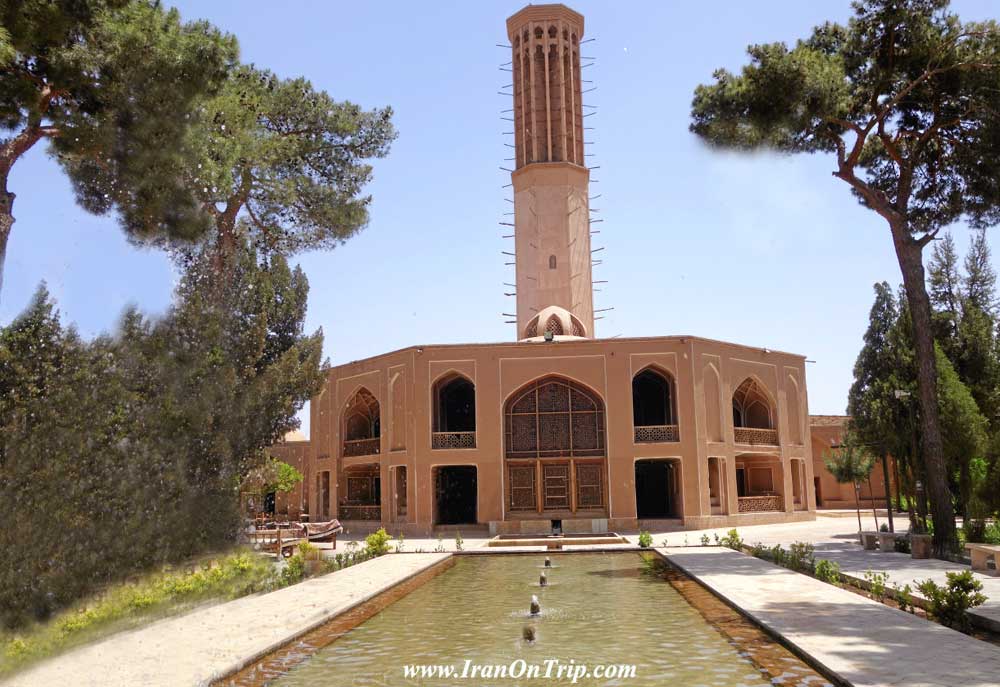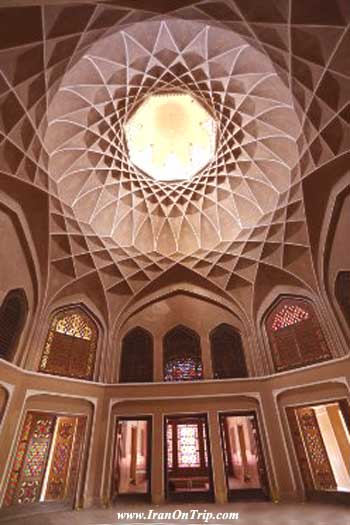Yazd Dowlatabad Garden

Dowlatabad Garden located in Yazd, central Iran, is a Persian architecture jewels.
The Garden is an authentic Iranian garden that annually attracts thousands of domestic and foreign tourists.
This is a complex built according to the original Iranian architectural style and consists of a large garden and some buildings.
Looking at the garden and the main entrance of the garden, you will see the long pool in the shade of the tall cypress trees leading to the main entrance. On the way to the mansion, there are beautiful grapes and pomegranates trees behind those tall trees.
Before you see the garden or even the walls of the house, from hundreds of meters away and some streets away from that spot, you can see the tallest wind catcher of the mansion inside the garden.
This traditional air-conditioning system of local houses around the desert in Iran is the essential elements at the residential structures. However, the exaggerated grand size of this wind catcher functioned perfectly well.
The building has got a large stain-glass window that could be pushed up and down to have the air in. At the central section of the building there is a small pool which adds some humidity to the dry air of this house in the heart of desert, in Yazd. It looks like a central open air section where you can see the windows of the upper floor and corridors leading to the exterior corners of the house. It is at these corners that you can find the staircases leading to upstairs.
Mohammad Taghi Khan known as the Great Khan was the progenitor of the dynasty of all Khans in Yazd excavating a qanat named Dowlatabad, later on.
He commenced constructing the estate of Dowlatabad Garden as his residence along the water extending from the qanat. The magnificent estate abounds with a vestibule, a soaring wind catcher, a veranda covered with mirror, and the splendid façade.
The lush garden is a paradise where different trees like pine and cypress, various flowers like roses and fruit trees like grape and pomegranate abound, offering a green carpet panorama. The soaring 33.8 m-high wind catcher, the highest one in the world, makes the estate really unique, creating a spectacular vista.
The most significant characteristics of the design of this building is believed to be the attempt of the architect in selecting tactful angles for providing the best views and landscape internally.
Dowlatabad Garden complex includes the southern frontispiece building, the vestibule building and the wind catcher (bad-gir), the summer building or Harem, Behesht building, the mirror hall building, Tehrani building, the main frontispiece building and a double-spanned water cistern.
The mansion inside this walled garden is a unique octagonal-plan mansion with colorful stain glasses within sash window panes. In addition to a long pool in front of the building, there are some small ones inside the building and a room accommodating a small pool underneath the wind catcher, which is still the largest in the city.
Dowlatabad garden is regarded as one of the sites worth visiting due to verdant gardening skill in landscape architecture, irrigation method, and in the richness of architectural design. It is for this reason that the same has been recorded as a historic building.
Dowlatabad is among the Persian gardens that have just been registered on UNESCO's World Heritage List as one of the masterpieces of traditional gardens.
Persian Gardens on World Heritage List

The Persian garden was registered on UNESCO’s World Heritage List on Monday (June 26th).
The decision to register the property on the list was made during the 35th session of the World Heritage Committee, which opened in Paris on June 19.
The committee composed of members from 21 countries discussed the profiles of nine Iranian gardens to add the property to the list.
Information about the gardens of Pasargadae and Eram in Fars Province, Pahlebanpur and Dowlatabad in Yazd Province, Fin and Chehel Sotun in Isfahan Province, Akbarieh in South Khorasan Province, Abbasabad in Mazandaran Province, Shahzadeh Mahan (also known as Shazdeh) in Kerman Province were previously submitted to the UNESCO World Heritage Center.
These gardens exemplify the diversity of Persian garden designs that evolved and adapted to different climate conditions while retaining principles that have their roots in the times of Cyrus the Great, king of Persian from c. 558–529 BC.
The Persian garden was conceived to symbolize Eden and the four Zoroastrian elements of sky, earth, water and plants. Water plays an important role in the ornamentation of the gardens.
Dating back to different periods, the gardens consist of buildings, pavilions and walls, as well as sophisticated irrigation systems. They have influenced the art of garden design as far as India and Spain.
.....
.....
.....

.jpg)



























